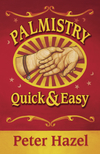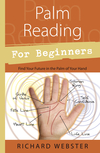Palmistry: The Value of Hands

Why do hands fascinate us? Do hands have a hidden meaning? Nearly all of us have wondered about something we see in our own hands or spot in another person's hands. No two hands are completely alike, not even for the same person, and no set of hands exactly resembles another set of hands. The differences can be eye-catching.
Once you notice something different about your hands, or another person's, you can only go so far in pondering what tales that the hands have to tell—if only someone could read it.
Wouldn't you be surprised to know that not only do hands have a meaning beyond the obvious—their everyday use—but that with almost no effort, you yourself can access a few of the messages of the hands. Because, without realizing it, you are already skilled in decoding information that hands offer.
Here you might object, "Wait! I don't know how to read hands!" The answer to that is yes, you do, intuitively receiving impressions all the time, often reacting to clues from the hands' shape, size, gestures, and posture. These things you can and do see from a distance, or across a room, or across a tabletop, as you interact with family, friends and neighbors.
How many times have you thought, "I don't like that person," based on their handshake, or on the contrary, felt very drawn to someone after you shake their hand? Even on a casual level, hands telegraph much about a person's personality and character.
Of course, there is much more to hands than their posture, shape, or their "feel" when you shake hands. Ways to analyze all the features in a hand can be found in palmistry and hand interpretation books. Information in these books is based on systems developed over centuries of observation, systems that have been tried and tested until the meanings attributed to any one sign in the hand have been proven to work.
You may wonder why hands have this type of information. It's because the hands are closely tied to the action of the brain, which directs your hands every minute of the day. Your brain has much to say about your skills, what you have learned, how you have processed your experiences—and so do the hands, which are in many ways expressing what the brain already knows.
This is great news for anyone who really wants to know more about hands, to get answers to questions people typically ask, such as:
- Why is this line longer than that one?
- Someone told me I have a star on my palm, what does that mean?
- Her fingers are so short and his are very long. What's the difference?
- What does a thick thumb tip mean?
Palmistry books are a powerful resource for all students of human nature: teachers, psychologists, counselors of all types, human resource employees, professionals, and anyone who simply wants to follow that instinctive desire to know what hands can tell us.
Just as with any subject, palmistry can be as simple or complicated as various levels of knowledge dictate. If you just want to understand your partner, you might learn all about hand shapes, flexibility, and consistency in the palm, and leave it at that. If you want a bit more detail, you can factor in the meanings for the length of the palms, fingers, and nails. If you want to become an expert at understanding the hand, you will study all the lines and markings in the palm, as well as fingerprints and patterns in the skin ridges on the palm's surface.
Expert or casual observer, you will benefit enormously from knowing something about the hands. You can entertain your friends, learn more about the people in your life, or even open a private practice reading hands, if your interest and dedication carry you that far.
The list of attributes to analyze in a hand may surprise you, because it is so detailed. The beauty of palmistry is that you can pick and choose which features of the hand appeal most to you, and learn them thoroughly, to match the level of practice you want to establish.
Palmistry's study includes the analysis of these areas of the hands:
- Size—of the whole hand, the palm, and fingers
- Shape—for the palm, fingertips, and nails
- Length—seen on the palm, the fingers, and nails
- Consistency—felt on the palm's surface when you touch it
- Flexibility—found on the fingers and thumb
- Thickness—of the palm and fingers
- Color—found on the palm's surface and under the nails
- Mounts—individual sections of the palm, each of which has its own meaning
- Lines—three major lines, a handful of minor lines, and many fine lines
Each of these areas reveal something of your personality, energy, temperament, emotions, talents, aspirations, and dreams, and the ability to make them come true. You can get confirmation from your hands that your life is on the right track, that your energy is taking a positive turn and to see how your past experiences have shaped you. What impression have they left in your hands? How strong are you? Will you succeed?
Hands answer all this, and more. You can learn not only about yourself and your goals, but can assess potential in other people, and if interested, use palmistry as a tool to check on your compatibility with another person. Even if you only learn a little bit, you could talk to groups of friends to entertain them, or use the valuable clues that the hands hold as a starting point to discuss your lives.
The blessing of palmistry is that you can expand your awareness of the whole energy field that makes you who you are. At the same time, you can find the answer to curiosities you have about the differences in every hand. If you follow the urge to know more about hands, you will be richly rewarded by your study. Enjoy the journey!
About Judith Hipskind
Related Products


is subject to certain Terms and Conditions